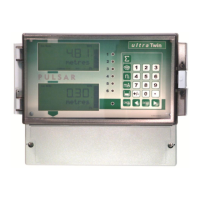Page 137
Consider the example of an application using 2 pumps. Each pump is
connected and controlled by one of the Twin relay outputs, the pump duty
and setpoints have been programmed as detailed in Using the Relays,
earlier in this chapter. The signals providing details on the “lead” or “duty”
pump ‘status’ are connected to the digital inputs as described in Chapter 2
Installation, and the input Type P*372, 375, 378, 381, 384, 387, 390 is
configured as detailed in Input Type, earlier in this chapter.
Pump 1 is connected and programmed to operate on Relay 1
Pump 2 is connected and programmed to operate on Relay 2
Duty Input 1 signal is connected to Digital Input 3
Duty Input 2 signal is connected to Digital Input 4
When no signals are present on either Digital Input 3 or Digital Input 4 then
devices will run in the “auto” mode, as determined by the Twin, in
accordance with its programmed settings. If a signal is seen on Digital Input
3, duty selected for Pump 1, then the pump connected to Relay 1 will
assume the role of “lead”/”duty” pump, regardless of the settings
programmed in the Twin. When the level rises to the ON Setpoint, for the
first pump, relay 1 will energise and Pump 1 will ‘start’, in the normal
manner. If the level continues to rise then relay 2 will energise and Pump 2
will start in accordance with the settings programmed for pump 2.
If a signal is seen on Digital Input 4, duty selected for Pump 2, then the
pump connected to Relay 2 will assume the role of “lead”/”duty” pump,
regardless of the settings programmed in the Twin. When the level rises to
the ON Setpoint, for the first pump, the relay 2 will energise and Pump 2
will ‘start’, in the normal manner. If the level continues to rise then relay 1
will energise and Pump 1 will start in accordance with the settings
programmed for pump 2.
Override
A digital input can be assigned to receive an input, which will override the
setpoints of the pumps and start them, as determined by the Override Level
(P*306) and providing the level is above the Min. Override (P*303),
immediately after the expiry of the Override Delay (P*302). A digital input
can also be assigned to receive an input, which will override the setpoints of
the pumps and stop them immediately after the expiry of the Override
Delay (P*302).

